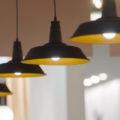You might want to consider these aspects first. But if you are unsure which LED light bulbs are suitable for you, SimplyLED’s experienced customer service team are available to offer you advice and guidance.
Voltage
Some LED light bulbs work with 230 volt mains AC (Alternating Current) electricity, for example the GU10 LED light bulbs. Others, like the MR16 LED bulbs, run on 12 volt DC (Direct Current).
Mains voltage LED light bulbs (such as GU10, B22 and E27 bulbs) have a built-in driver and can simply be swapped out with your regular bulbs. However, some other bulbs, such as MR16 and other 12V bulbs, require the use of an external 12V driver. If you are replacing existing incandescent 12V bulbs you will need to replace the transformer with a special LED driver.
Wattage and power
You can’t compare the wattage of LED and other types of bulbs directly – that’s because LED light bulbs use a lot less electricity. You need to compare the approximate ‘equivalent incandescent wattage’ quoted on the bulb’s packaging.
You may also find the light output of bulbs quoted in Lumens, although this can be misleading as manufacturers don’t always measure this in a consistent way. If you have an existing 50 W GU10 halogen bulb, you can also choose to replace it with a cheaper, less bright bulb.
Size and base fitting
LED light bulbs are designed to be direct replacements for existing bulbs. You need to make sure that not only is the base fitting the same, but the physical dimensions are the same. A good example of this is the MR11 LED.
Although similar to the MR16 LED, the MR11 is a smaller size bulb. Don’t rely on a photograph or illustration – this caught many people out when they changed from incandescent bulbs to CFLs (Compact Fluorescent Lights).
As long as you match the base fitting code (a GU10 LED will fit the same base as a GU10 Halogen or CFL), you only need to check the new bulb’s dimensions against the old.
Colour
In this context, we’re not really thinking about red, green or blue, but rather the shade of white light produced. White bulbs are labelled according to their colour temperature (see our article on the Kelvin scale).
The industry standard term ‘warm white’ refers to bulbs with a colour temperature of 3000 K. This colour temperature is the nearest equivalent to normal incandescent and halogen bulbs.
Bulbs with a colour temperature of 6000 K are described as ‘cool white’ – they appear brighter and produce a bluish light which is ideal for feature and accented lighting. As the name suggests, ‘cool white’ bulbs can seem cold, clinical, or even harsh when used as the main domestic illumination, but are very common in commercial and public places.
Other terms you may come across include ‘pure white’ or ‘daylight’ – be sure to check the colour temperature of these bulbs.
Beam angle
The beam angle describes how wide or narrow the beam of light is coming from the bulb. A narrow 45° angle produces a narrow focused beam, suitable for highlighting an object or small area, and you’ll be able to see a clear circle of light.
With a higher beam angle, the bulb may not appear as bright as a narrow beam bulb because the light spreads over a much larger area – the circle of light may not be visible, or have very hazy edges. The wide beam light is suitable for more general illumination such as areas in a kitchen.
Life expectancy
The long life of LED light bulbs is one reason they save you so much money (the other is the small amount of electricity they use). Most manufacturers say you can expect about 50,000 hours’ life from an LED.
Other manufacturers are more conservative quoting 30,000 hours, while some recent claims of 100,000 hours are difficult to verify. Compared to the typical 2,000 hour life of a halogen bulb, your LED light bulbs should last 25 times as long – that’s over 17 years at 8 hours a day! In case you were wondering, LED light bulbs usually come with a 1 year warranty.
Dimmable LED light bulbs?
Have you got dimmer switches? The lack of dimmable bulbs is often quoted as a problem with CFLs (Compact Fluorescent Lights), leaving many people without a low energy option. Enter the dimmable LED!
During 2010, LED manufacturers recognised the need for low energy dimmable bulbs, and now dimmable LED versions are available for many types of bulb. If the type you need isn’t available yet, it soon will be as manufacturers add to the range of dimmable LED light bulbs. Dimmable LED light bulbs are a little more expensive, but they will still give you huge savings compared to incandescent bulbs.
Price
Yes, LED light bulbs are more expensive to buy compared to incandescent, halogen and energy-saving CFLs. New technologies produced in small numbers are always more expensive to start with – remember how much flat-screen TVs used to cost?
But even with the current purchase price of LED light bulbs, you’ll probably be making savings within the first year. And when you consider your LED light bulbs could last 15 of more years, the savings will continue to mount up.
In commercial or public premises where lots of lights are on for extended periods, a change to the cooler-running LED light bulbs will reduce the need for air conditioning to keep the temperature down, with a subsequent reduction in electrical energy use.
Prices have already reduced to the point where LED light bulbs are now an affordable and viable alternative.
Some retailers may have kept their prices artificially high while LED light bulbs are scarce and a novelty. Now LED light bulbs are becoming a mainstream product, competition will ensured this practice doesn’t continue.
The Internet and a willingness to buy online has ensured there are often better deals on retailers’ websites than in traditional DIY and lighting stores. A further development has been the appearance of specialist companies and websites which often offer better deals when buying in quantity.
You should look out for websites which appear to be cheaper because they don’t quote prices including VAT, and have hidden delivery charges.
Environmental factors
With so much emphasis on the cost savings of LED light bulbs, it’s easy to overlook the environmental advantages. As LED light bulbs use a lot less electricity, less fuel is needed to generate the electricity, with a corresponding reduction in harmful emissions from power stations.
LED light bulbs do not include hazardous chemicals. This is a further environmental benefit. One major disadvantage of CFLs (Compact Fluorescent Lights) is the mercury vapour and other chemicals which are inside the tube.
Not only is manufacture hazardous, but disposal needs to be highly specialised. And if the CFL tube gets broken, the mercury and other chemicals escape into the atmosphere. Which ever way you look at it, LED light bulbs are the green option.
What do you think? Is there anything else you’d like to know about before buying LED light bulbs?





This is a great article. Thanks a lot for bothering to detail this all out for us. It really is a great help!
As a Newbie, I am constantly searching online for articles that can benefit me. Thank you
I have searched high and low but have yet to find an article that explains *why* I need a special led-driver instead of simply using my existing transformer when looking for an LED bulb to replace the 12v Halogen downlighter in my shower room. Is it that the LED driver produces a smoother, less spiky supply? Are LEDs susceptible to something that halogens arne’t (apart from heat)? Can we have an answer to this please? I want to make the switch but would struggle to justify the effort/cost of an expensive LED bulb *and* a special driver too!
Hi Roger,
Thank you for taking the time to read our blog!
I will try to answer your question as accurately as possible:
In some cases you may find that actually, a low voltage LED bulb will replace your existing Halogen downlight with no problems at all. However, generally it is still recommended to change to an LED driver as this will avoid unwanted flickering or poor performance that can occur when in use with legacy drivers/ transformers (the older style). Using an LED compatible driver with an LED bulb will also ensure you achieve the maximum lifespan from the lamp (generally up to 50,000hrs) as this style of driver will minimalism any spikes in power- As only a small amount of power is needed to illuminate the LED bulb, small surges in the supply will often cause the LED bulb to fail unexpectedly.
We can understand that having to change all of your drivers over may seem daunting, to say the least and depending on how your circuit is configured (one driver per bulb or one larger driver that runs several bulbs) it can also be a timely and costly experience too. A lot of our customers will take advantage of our 14 day returns policy in this case and try a few of our bubs in their existing fittings (with original drivers). After trialling the lamps in your existing fittings you should be able to gauge the lamps performance and see if any flickering occurs etc. the worst case scenario being you have to send the bulbs back to us for a refund.
Another option would be to consider changing over to a mains power bulb (GU10 spotlight LED). Whilst this will still involve a fair amount of work (changing the lamp holders over to the correct GU10 fitting) the prices will balance out (often changing over is a little cheaper) and you will be left with a more flexible bulb (these are mostly Dimmable if needed, unlike our own MR16 12v which are Non- Dimmable) and a bulb that has an integral driver (so you can get rid of the ones you have in place already).
Finally, the easiest option…
I hope this helps make sense of this issue a little or at least offers some solutions. I have including some links in this text to the various products I have described too.
I thought that as the email was long enough already, I should not bombard you with too much more information, but of course if you would like some more help or clarification we would be more than happy to speak to you over the phone and advise you further. We can be reached via email or phone 9-5 Monday- Friday using the following details:
01494 720 450
Love your blog!
Hi there,
Sorry about that our drivers are temporarily out of stock, but we are expecting more soon. I hope you managed to get one in the end.
I read with interest your blog, but from what I could understand, most Mains Led bulbs are equivalents to halogen bubs.
I have replaced ALL the incandescent bubs in my home with CFL’s, however as they need to be replaced, I would like to replace them with the appropriate wattage mains LED bub/
Would it be at all possible for you to give say an equivalent wattage for either a CFL and/or an incandescent fitting?
Hi,
If you phone us, our customer service team will help you with your enquiry.
Thanks.
Im trying to understand why i would need a driver for MR16 if i am wanting to use them to light my off-grod home which uses only 12v batteries for power. It seems crazy i would have to invert my power to AC then use a driver to create DC. However, ive been searching the web for months and no one talks about running these things off actual 12vDC current. Is it not possible?
I would like to change my kitchen downlights (12v mr16 20w set of 8) to 5 watt LEDs they are currently powered from a 12v 160 watt transformer
Will it be ok to replace the transformer with a single 40 watt LED driver and keep the existing wiring layout as it is?
My trailer has 24 volts. Do I specifically have to have a 24 volt led bulb. I see bulbs for sell advertised as 12/24 volts. Thanks
I replaced all my halogen bulbs for led ones and wish I hadnt! they dont seem to last for more than a few months before they flicker and dim. Im no electrician but did wonder if its the light fittings that are the problem as they are old (1987) . Its getting quite costly having to replace them, I never had any issues with the halogen bulbs, some I had were over 6 years old! Am considering going back to halogen bulbs.
( As Im in rented accommodation I can not change all the light fixtures)